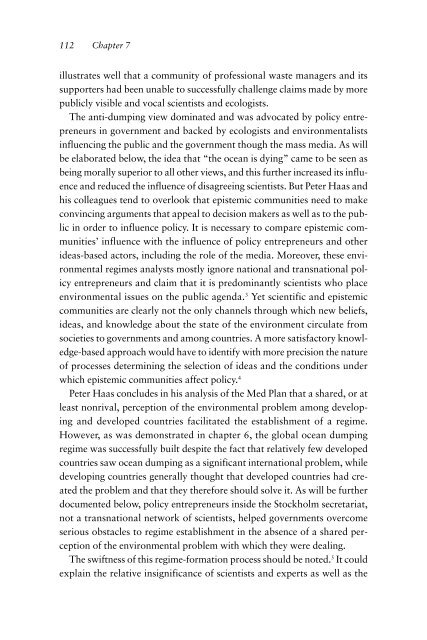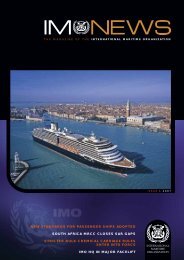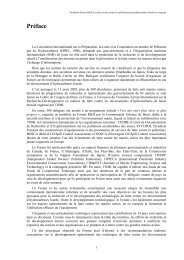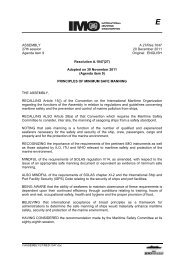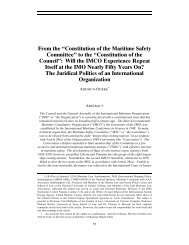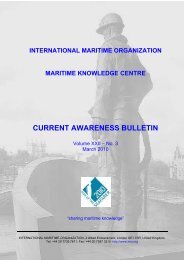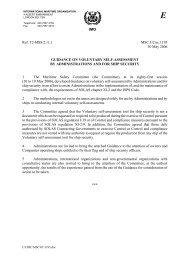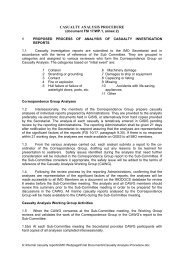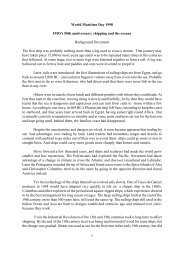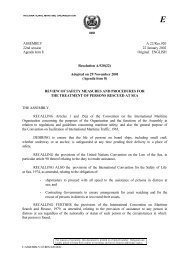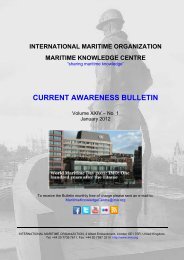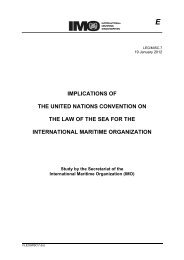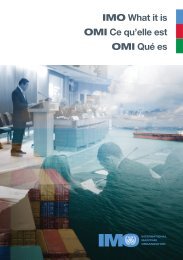Radioactive Waste Disposal at Sea: Public Ideas ... - IMO
Radioactive Waste Disposal at Sea: Public Ideas ... - IMO
Radioactive Waste Disposal at Sea: Public Ideas ... - IMO
You also want an ePaper? Increase the reach of your titles
YUMPU automatically turns print PDFs into web optimized ePapers that Google loves.
112 Chapter 7<br />
illustr<strong>at</strong>es well th<strong>at</strong> a community of professional waste managers and its<br />
supporters had been unable to successfully challenge claims made by more<br />
publicly visible and vocal scientists and ecologists.<br />
The anti-dumping view domin<strong>at</strong>ed and was advoc<strong>at</strong>ed by policy entrepreneurs<br />
in government and backed by ecologists and environmentalists<br />
influencing the public and the government though the mass media. As will<br />
be elabor<strong>at</strong>ed below, the idea th<strong>at</strong> “the ocean is dying” came to be seen as<br />
being morally superior to all other views, and this further increased its influence<br />
and reduced the influence of disagreeing scientists. But Peter Haas and<br />
his colleagues tend to overlook th<strong>at</strong> epistemic communities need to make<br />
convincing arguments th<strong>at</strong> appeal to decision makers as well as to the public<br />
in order to influence policy. It is necessary to compare epistemic communities’<br />
influence with the influence of policy entrepreneurs and other<br />
ideas-based actors, including the role of the media. Moreover, these environmental<br />
regimes analysts mostly ignore n<strong>at</strong>ional and transn<strong>at</strong>ional policy<br />
entrepreneurs and claim th<strong>at</strong> it is predominantly scientists who place<br />
environmental issues on the public agenda. 3 Yet scientific and epistemic<br />
communities are clearly not the only channels through which new beliefs,<br />
ideas, and knowledge about the st<strong>at</strong>e of the environment circul<strong>at</strong>e from<br />
societies to governments and among countries. A more s<strong>at</strong>isfactory knowledge-based<br />
approach would have to identify with more precision the n<strong>at</strong>ure<br />
of processes determining the selection of ideas and the conditions under<br />
which epistemic communities affect policy. 4<br />
Peter Haas concludes in his analysis of the Med Plan th<strong>at</strong> a shared, or <strong>at</strong><br />
least nonrival, perception of the environmental problem among developing<br />
and developed countries facilit<strong>at</strong>ed the establishment of a regime.<br />
However, as was demonstr<strong>at</strong>ed in chapter 6, the global ocean dumping<br />
regime was successfully built despite the fact th<strong>at</strong> rel<strong>at</strong>ively few developed<br />
countries saw ocean dumping as a significant intern<strong>at</strong>ional problem, while<br />
developing countries generally thought th<strong>at</strong> developed countries had cre<strong>at</strong>ed<br />
the problem and th<strong>at</strong> they therefore should solve it. As will be further<br />
documented below, policy entrepreneurs inside the Stockholm secretari<strong>at</strong>,<br />
not a transn<strong>at</strong>ional network of scientists, helped governments overcome<br />
serious obstacles to regime establishment in the absence of a shared perception<br />
of the environmental problem with which they were dealing.<br />
The swiftness of this regime-form<strong>at</strong>ion process should be noted. 5 It could<br />
explain the rel<strong>at</strong>ive insignificance of scientists and experts as well as the


